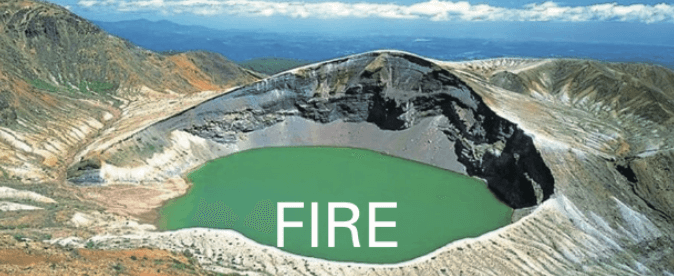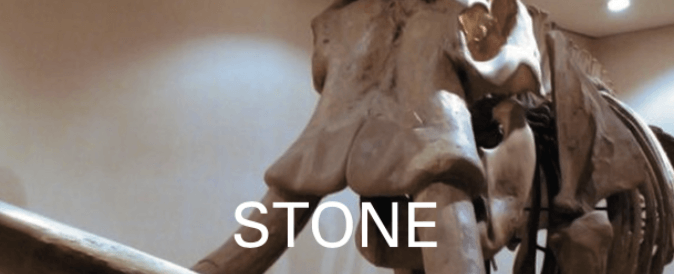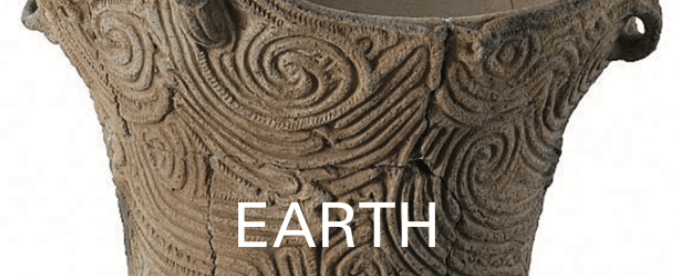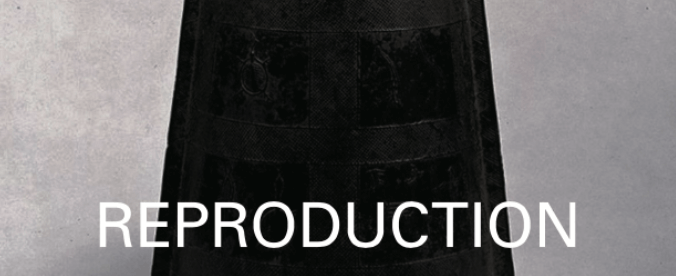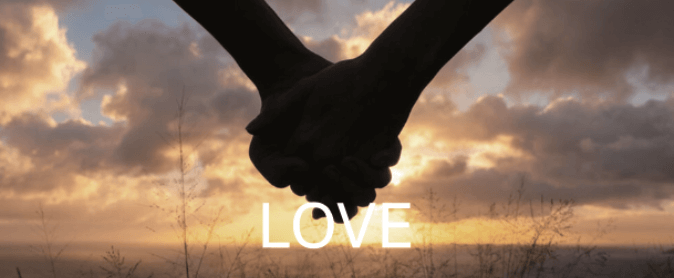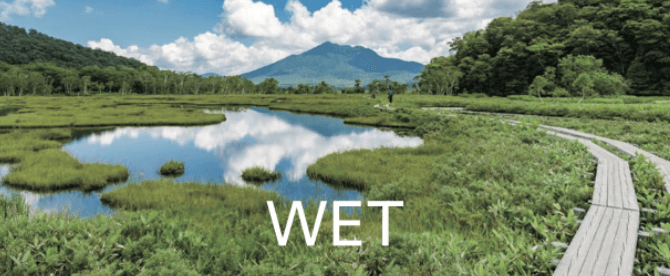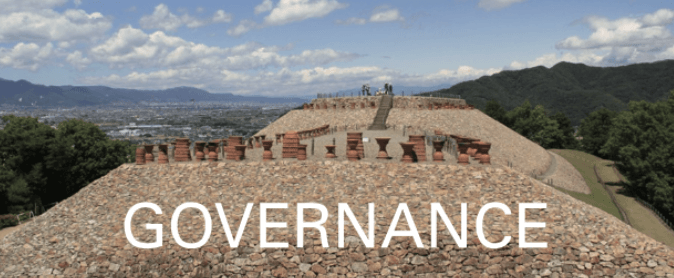
It is a square shaped tomb in a lateral holed, stone room. It is estimated that the construction dates back to the beginning of the 7th century. The enclosure of the upper part has already been lost and the giant stone is exposed.
This tumulus seems to be the burial mound of Soga no Umako (550?-626), who was an Oomi, the highest officer in national politics during the Yamato dynasty. According to the excavation investigation, the household was 7.7m long, about 3.5m wide, 4.7m high. Large and small 30 granites were used. The weight of the stone used on the ceiling, the northern side, was about 64t, and the southern side was about 77t.
The gross weight was about 2,300t. 1300 years later, the stone works did not collapse even after the Hanshin Awaji Great Earthquake, with a seismic intensity of about 5. It shows the precise process of carefully preparing the surface of a large stone.
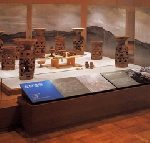
This museum is located at the Furu site, which is the largest archeological site around Tenri City. This museum restored the ceremony from the ancient time of the Tumulus period (the 3rd– 7th century), with clay images from the Furu site and others.
The Furu site is compound ruins, since the Paleolithic Period, which is in the area of approximately 2 km east-west and 2 km north-south, interposed the Furu River and is mostly within the Tenri sect’s facilities. A chief’s house, workshop, and festival hall were set up in this site from the end of the Yayoi period (the 4th BC – 3rd century), to the Tumulus period (the 3rd– 7th century).
It seems this site was derived from the Mononobe clan, a powerful military clan by the 6th century, which was based here.
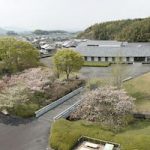
This museum focuses on the excavation research by Nara National Research Institute for Cultural Properties. It exhibits a number of important cultural properties, including Shumisenseki, stone objects for garden fountains, stone carvings from the Ishigami ruins, and mirrors from the Takamatsuzuka ancient mound.
You must see the buried articles of the tower of Asuka-dera, the oldest temple in Japan, and the east corridor of Yamada-dera, which was discovered as it was collapsed.
And this museum holds the Kitora tomb exhibition, featuring wall paintings of four Gods. The 7th-8th Century Kitora Tombs are less influenced by the Tang Dynasty culture of China. It is estimated that the construction was made before the Japanese envoy to the Tang Dynasty returned home.
The stone chamber was lacquered, and the ceiling has a celestial map. Inner walls were adorned with colored paintings. On the south wall, the Suzaku, the Vermilion Bird that ruled over the southern heavens, expresses a three-dimensional effect, by the technique of shading, gradation, and color.

“Mastering the Great Land in ancient Japan” —During the Paleolithic age and Jomon period, 15,000 ‒ 2,300 years ago, the Yura River repeatedly overflowed. Immigrants during the Yayoi period, 2,000 years ago, improved the river stream, developed the land, and started the sericulture industry. No Nation ever emerged without mastering the land.
The museum exhibits relics excavated from the largest burial mound in Kyoto, the Kisaichi Maruyama Tumulus, built in the middle of the 5th century. These include gilt bronze arrow bags, armor, and metal fittings as burial accessories, along with iron farming implements. The burial person was connected to the immigrant, the Han clan. The River stream Improvement and mound construction were connected by the movement of earth and sand.
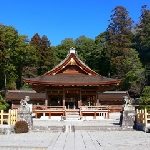
“Worshiping the Great Land Master in ancient Japan” -This shrine enshrines Okuninushi no kami, as the god of nation-building and development farming. Around the 2nd Century BC, bronze and iron ware were introduced to Japan. Those wares required mercury and limonite. This area had those resources. This knowledge and engineering also developed farming and built nations in ancient Japan.
The object enshrined here is Mt. Mikageyama. The public is still prohibited from entering this shrine. Okuninushi no kami, a deity, developed the gorge between Kameoka and Arashiyama, which was the ancient lake, and then left for Izumo Province, Shimane Prefecture.
This shrine used to be in Tanba Province. The “Tan” of Tanba Province is a precious ore containing mercury, since ancient times. Izumo means “rising cloud.” It is said around this shrine that the cloud of Izumo originated from the sea of clouds of Mt. Mikageyama.
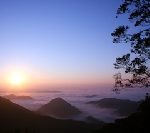
The Oeyama mountain range (Height 833m) runs along the base of the Tango Peninsula. A sea of clouds over the mountain range is famous, which is created with moisture and radiative cooling that enter from the Sea of Japan in spring and autumn.
The Oeyama mountain range also has the legend of Shuten-doji (ogre). Shuten-doji had the pale red face, the short and disordered red hair, the hands and feet like the limbs of a bear, who lived in a palace like Ryugu (dragon palace), and had many subordinate demons.
In the vicinity of the Oeyama mountain range, there was a village with a civilization of steelmaking technology: Tatara – an iron manufacturing method to use iron sand, that actually enshrined the mountain god.
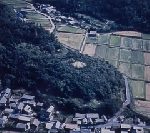
Behind the Tango City Ancient Villege Museum, there is Sinmeiyama Tomb, the largest keyhole tomb on the Japan Sea side. Its total length is 190m and was built in the 4th and 5th centuries. It was situated so that a view of the Japan Sea is available from the top of the mountain.
Why was a huge tomb built in the area of little farmland near the mouth of the Takeno River? Because there used to be a cove at that time.There was a port by the side of the tomb, and the ancient Tango king was deeply involved in maritime trade.
In addition, the person who rowed the boat is drawn in the Haniwa (clay image) in the tomb, is filled with the view and the history
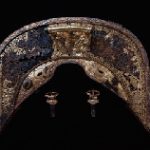
This museum introduces the history of Yamato, which is the cornerstone of Japanese history, through artifacts excavated in Nara Prefecture. A good example is Fujinoki tomb, from the Ikaruga Town of Ikoma district , which was discovered as an unearthed tomb in 1985.
The gold and bronze saddle excavated there has Palmetto (Buddhist arabesque pattern) motifs, such as Chinese phoenix, dragons, demon masks, and monster fish and lions. Horses that came to the Japanese Islands about 1600 years ago were decorated with golden harnesses as a symbol of authority.
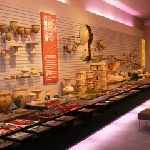
A person rowing a boat — A line-engraved piece of a cylindrical clay figure was excavated from Shimaiyama Tumulus. Shimaiyama Tumulus is a keyhole tomb, with a total length of 190m, was built at the end of the 4th and the beginning of 5th century, the middle Tumulus period (the 3rd – 7th century). It is the largest tomb on the Sea of Japan side.
At that time, this area was a bay with a harbor beside it, and the ancient King of Tango Province was deeply involved in maritime trade. This museum, next to Shimaiyama Tumulus, introduces a real image of the powerful family on the sea, who used to rule Tango Province.
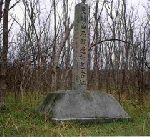
Kumihamacho town was the center of Kumi-sho, village, which was the manor of Choko-do Temple, in the Rokujo no miya Palace of Cloistered Emperor Go-Shirakawa (1127 – 1192).
The village flourished, which was described in “Ie gohyaku ken mune, – 500 houses and residence”, at Odankacho, of Tango Province, A notebook that Onshi in Ise, the priest who encouraged a pilgrimage to Ise, described their supporters in Tango Province. The site of Hoishihama beach shows the origin of its growth.
A Kasen copper coin from the Xin Dynasty (8 – 23AD), ruins of manufacturing ornamental bead, and copper iron products were excavated. In ancient times, Hakoishi Harbor was an important trading port.

The Yura River pours into the Japan Sea, passing through the Fukuchiyama Basin, where culture from overseas had taken root since ancient times. This shrine is located near the estuary of the Yura River.
The enshrined deities are Izanagi, a male deity who fathered Japan and Kushigokenomikoto (Susano-no-Mikoto, the younger brother of Amaterasu Oomikami: Sun Goddess and mythical ancestress of the Japanese imperial line, and a local deity linked with the harvest and agriculture), the son of Izanagi, a god to preside over plantation and agriculture, which were transferred the separated spirit to this shrine from Izumo Kumano jinja shrine, Shimane.
This shrine used to consist of Uenomiya, Nakanomiya, Shimonomiya, the three buildings of the shrine complex were built on the different level grounds. They were joined by Nakanomiya in 1711. Yura, which had a mountain faith since ancient times, was an important gateway from the Japan Sea.
The marine clans aimed for the Fukuchiyama Basin from Yura.

In this museum you can call back the Tenpyo culture (8th century) with a model of the Kii Kokubunji temple and others. In addition, this museum introduces the ancient culture and history of Kishu domain, through luxurious burial accessories, such as gold jewels, Magatama (ancient Japanese ornamental stones) and harnesses connected to the Korean peninsula excavated from the tombs along the Kinokawa River.
The Ki family, king of Kishuu domain, is said to originate from the ancestor of Takenouchi no Sukune, a migratory clan. It was said that Ki family serviced well the 5 Emperors in Kawachi Osaka, who had paid tribute to the Eastern Jin dynasty (317-410), Sung Dynasty (420-479) and were appointed as King of Japan.

“You will find the ancient elephant in the Paleolithic Age” -Akashi is on a complex landscape of Hills and Plains. 2 million years ago, it was the floor of a lake. In those days, the ancient elephant, Akashizou (Stegodon Aurorae), and great deer, which were as large as cows, stayed lakeside. This museum shows the skeleton specimen of the ancient elephant excavated here.
At this museum, you can learn about the history and culture of Akashi from ancient times to the present, and it introduces the dawn of Akashi City. Although the fossilized human bones of Akashi-Genjin, the humans in Akashi were lost in the Tokyo air raid during World War II, a piece of wood, with traces of human modification, was found in the same stratum where Akashi-Genjin was found on the Akashi coast, from 120,000 to 50,000 years ago. As a result, it was almost certain that Akashi had humans during that time.
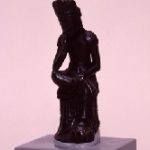
The Ibogawa River originates in the Chugoku Mountains, which has a lot of iron sand, produced since ancient times, that pours into the Harima-nada Sea. This museum introduces the history along the Ibo River, in the Stone Age, in the Jomon period (16,000 years ago – 3,000 years ago), in the Yayoi period (the 4th BC – 3rd century) and in the Tumulus period (the 3rd– 7th century) via excavated relics.
This statue with 11cm Height Asuka-era gold bronze Buddha, preserved from Tatsuno town’s Enkakuji temple is a gilt bronze statue of the Buddha in the Asuka period (550 -710). It is also known as the statue of Maitreya Bodhisattva, which is a bronze casting, with gilding of the a mid-7th century statue. It shows the path of civilization from the Chinese continent and Korean peninsula.

“This is a miracle: Jomon and Yayoi ware are still alive! ” -Tsuzura Ozaki is a peninsula at northern Lake Biwa, the largest freshwater lake in Japan. This site is at the floor of the lake, with water depth of 10 ‒70 meters, at the start of this peninsula. This lake floor has preserved well the relics spanning over 15,000 years. They have even kept their original color.
There is no river that causes sedimentation in the surrounding area, and the ancient terrain remains the same. There is the discovered site on the bottom of the lake. However, it is a mystery why the Tsuzura Ozaki Lake Floor Site submerged. This museum exhibits and introduces the raised potteries from the Jomon period (16,000 years ago – 3,000 years ago) and from the Yayoi period (the 4th century BC – 3rd century).

This museum is located in the suburban hillock of Wakayama, which introduces the history of this place. Here a keyhole tomb was built during the Tumulus period, 1,750 – 1,400 years ago. The largest group of tombs in Japan were also built which indicates that this place used to flourish as a gate to foreign culture.
This museum exhibits a clay image in the shape of a bird to decollate Tumulus as a sacred place, a man-shaped clay figure with two faces, and Koroku, an arrow holder-shaped clay figure.
You can understand this place which was the core place of Kuni no Miyatsuko, the regional administrator of the Ki clan, which had a connection with the Korean Peninsula.
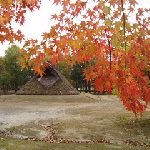
“A settlement compound spanning over 4,000 years” -This site is a great compound of settlements from the Jomon period, 5,000 years ago, to the Kamakura period, 13th-14th Century. This area of Shiso City is an ideal location for commuting from west to east, through the sea road of Setouchi, and from north to south, through the road of Tatara, an ancient iron manufacturing region.
The Shishiwa City History Museum in this park, introduces the history of the area, centering on the Ebara site, which is surrounded by the clear stream of the Ibo River and the rich forests, and was a Shogun demesne in the Edo period (1603 – 1868).
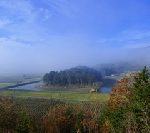
This tomb is the largest keyhole tomb in Tanba province, in Hyogo Prefecture. It has a total length of about 140m, and was built in the end of 5th century. The person buried here was Tanbano michinushino Mikoto, one of the four generals of Emperor Suijin.
The tombs that were filled with water in that moat are truly magnificent. Hichireikyo, the bronze mirror with 7 small bells on the periphery and other excavated items, shows that there was a powerful leader directly connected to the Emperor.
Excavated items were exhibited at the Sasayama City Historical Artifacts Museum.Those convey the high level of technology and life culture at that time.

The museum introduces Otsu, which has been an important hub since ancient times, and also possesses excavated articles from the ancient site. The 6th century Sueware pot, from the latter Tumulus period (the 3rd – 7th century), was excavated from Fukuro Tombs.
In the center of the ceiling, there is Haso, a small hole for musical instruments and sake bottles. Around the haso are two shrine maidens, a buck, a doe, and a deer hunter, with a bow and arrow, aiming at the deer. Sueware came from the Korean Peninsula in the 5th century.
Fukuro Tombs is located in the area of Nishikori and Sakamoto Otsu City, at the east foot of Mt. Hiei, where there is a densely populated site of tombs from the latter Tumulus period.
It is also the hometown of Ano shu, a group of stone wall craftsmen, who built castle walls in the early modern times.
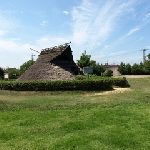
“You see Continental style arriving in the Yayoi Period” -This site is a large settlement, 500 meters long and 180 meters wide. The settlement developed during the late Yayoi period, 1st-3rd Century AD. The Continental style, large-scale cultivation, was done with the participation of continental and peninsula immigrants, using stone axes and ironware.
The museum introduces a large amount of earthenware and octopus’s pots that have been excavated, as well as bronze mirror pieces. It conveys the flow of life’s stability, through agriculture and fishing, and the transition to an ancient nation.

“Worshiping the Great Land Master in the ancient Harima region” -This shrine enshrines the Great God, Iwa no Ookami, as the god of nation-building and development farming, in the Harima region. Around the 2nd Century BC, bronze and iron ware were introduced to Japan. At that time, Wet-Rice farming expanded to Western Japan and created agricultural industrialization under the Great Land Master.
The Harimanokuni Fudoki, a description of regional climate, culture, and others in the Harima Province, said that Iwa no Ookami from Izumo Province was Onamuchi no kami. Onamuchi no kami developed the country, encouraged industry to open the way to stabilize lives, and established the regulation of medicine and taught the skill of cures, which created a nation. He was worshiped as the founder of Harima Province.

“You see the Continental style arriving in the Yayoi Period” -This museum conveys the ancient culture of Hyogo Prefecture. It is a lively place, with the carefree laughter and conversations of children. This museum neighbors the Onaka Site. There, you can see powerful, life-sized dioramas about the marine trade with Continent, via the Setuchi Inland Sea.
A full-scale ancient ship and a king’s coffin made of stone from Harima Province are exhibited and pit dwellings are restored in the adjoining historical park, “Harima Onaka Ancient Village.” At the entrance, earthenwares excavated in this prefecture are lined up by days, from the Jomon period (16,000 years ago – 3,000 years ago) to the Edo period (1603 – 1868).
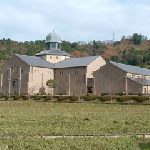
This museum is the center facility of the hill of Ohmi Fudoki, the description of Japanese regional climate, culture, and others. This museum introduces special historic sites, including Azuchijo, the site of Kannojijo castle, Hyotanyama tomb, and Dainaka no Kominami, the early agricultural settlements in ancient times.
This museum exhibits excavated archaeological materials and historical and art materials related to Oda Nobunaga (1534 – 1582), the legendary warlord and the military dictator and his vassals at all times.
—Azuchijo Castle was built on Mt. Azuchiyama like a cape that protrudes into Lake Biwa. Its interior was decorated with black lacquer and splendid wall painting.
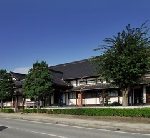
This museum exhibits Hichireikyo, the bronze mirror with 7 small bells on the periphery, excavated from Kumobekurumazuka Tomb, the only excavation in Hyogo Prefecture. This tomb was built in the end of the 5th century. Excavations include Kagamiita, a part of a Japanese horse bridle, which have bells as decoration.
These are extremely important properties as clues to understand the ancient history of the region. This museum introduces this city’s early modern time, including Tamba Sasayama, a castle town, and an exhibition of arms and armor.

The Biwa Lake has a 4 million year history and more than 1,000 species of flora and fauna, including endemic species. At this center, various ecosystems can be observed. The life of the lake is up to tens of thousands of years, due to the accumulation of earth and sand from the river.
The Ancient Biwa Lake was at the foot of the Suzuka Mountains in Mie prefecture, and sometimes turned into a river and moved to the north. It was in its current position and became the current shape 400,000 years ago.
The lake symbolizes the Japanese archipelago, which has changed its form over time and continues to exist for a long time.
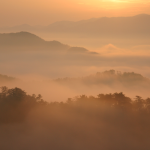
The basin of Tanba Sasayama used to be the bottom of the ancient lake, where red waves flooded. Tan (Tan sand) from Tanba is mercury. In ancient times, it was a precious mineral used for vermilion, gold plating, dyes, and pigments, to decorate the amulets and the Buddhist statues.
It was said “those who command Tanba Province would reign”, from ancient times to Akechi Mitsuhide (1528 – 1582): a feudal lord, a general under Oda Nobunaga (1534 – 1582), the legendary warlord and the military dictator. Mitsuhide rose in rebellion against Nobunaga in 1582, in the early modern times.
The waves of fog that flow into the basin awaken ancient memories.
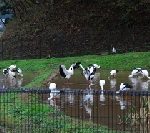
The Oriental White Stork is an East Asian bird that breeds in Northeastern China and the Amur River basin and passes the winter mainly in Southern China.
Although it had also lived in the Japan archipelago until the Edo period (1603 – 1868), it was threatened with extinction, due to excessive hunting and was designated as a national special natural monument. It appeared last around Toyooka City Hyogo Prefecture in 1971, and disappeared from the sky in Japan.
Artificial breeding stared in 1965, and this park is engaged in research on protection, breeding, expanding the breed, and reintroducing them to the wild, and working on an environment creation project that can coexist with storks.
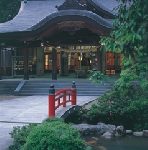
The Echuu Ichinomiya, Echuu Toyama’s most important provincial shrine, in Nanto Toyama, was registered in the Engi-Shiki, the code of Japanese governmental regulation in the 10th century. This shrine has the history of 2000 years, since Onamuchi no kami was enshrined.
Onamuchi no kami, is the god of matchmaking, land development, and agriculture. It is said that this god decided to remain the sprit here after presiding over Hokuriku, the region west of Tokyo on the Japan Sea, and returning to Izumo, Shimane.
This shrine appeared in national history as the highest shrine in Echuu during the Nara period in the 8th century. This shrine’s manor was also an Imperial property.
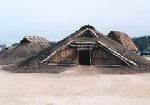
“The Largest Jomon site in Hokuriku, 4,000 years ago” – The scale of this site is 280 meters from east to west and 200 meters from north to south. On this site, there were pit dwelling houses surrounding raised-floor-style houses and open space for festivals. Highly artistic deep pots and unglazed earthenware formed cowrie were excavated. You will learn about the Jomon people’s organizing ability and deep spirit.
The Kitadai Site has the remains of a large settlement that represents the Hokuriku region. This pottery, from the Shinano River basin, has a different form from Kaendoki, earthenware decorated with the design of a flame, even though they were both from middle of the Jomon period (16,000 years ago – 3,000 years ago).

“Asahi town, Jade Beach in Japan”- Asahi town in Toyama is famous for its Jade Beach and Fudoudou Site, from the middle Jomon period, 5,500 to 5,000 years ago. Jade was made in a deep geological layer, 500 million years ago. 700,000 years ago, with the Fossa Magna, Jade traveled to the beach side Jomon settlements, through mountains, rivers, and the sea.
This museum exhibits archeological materials such as Jomon pottery, stone tools, and magatama, ornamental beads from Asahi Town.
The Fudoudou Site, a nationally designated historic site near the museum, has the remains of a large pit structure, with a 7m long elliptical shape, from east to west. It is similar to the Sannai Maruyama site in Aomori Prefecture. Four stone-walled furnaces are regularly arranged along the long axis inside a large pit structure. It indicates that a civilization existed here.

This plaza was a large settlement during the middle of the Jomon period, about 4500 years ago. Four or more sites of raised-floor-style houses were verified in the central part of this 56,000 sq. ft. site. A full-scale building was restored and excavated items were exhibited at Jomonkan. Techniques for knitting cloth, stone tools for tanning fur, and sewing needles, made of bones, were excavated.
Clay figurines have spiral, circles, and triangles patterns. These artifacts show that ingenuity and thought existed during those times.
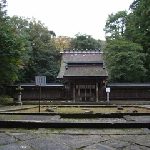
Wakasa Obama is a place that has thrived with culture and technology from overseas since ancient times. The Wakasa Ichinomiya, Wakasa Fukui’s most important provincial shrine, Wakasahiko jinja shrine consists of Wakasahiko Shrine, which enshrines Hikohodemi no mikoto, Yamasachihiko, and Wakasahime shrine, which enshrines Toyotama-hime.
In 714, it is said that those two gods descended to Shiraishi, the clear stream land of the Onyugawa River, Unose. It is famous in Japanese mythology as “Umisachihiko and Yamasachihiko”.
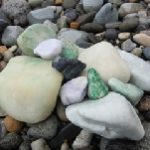
Miyazaki and Sakai Beach in Asahi Town, located at the eastern end of Toyama Prefecture, boasts the best water quality in the prefecture and is maintained as a swimming beach. They are said to be the Jade Beach, along with the beach of Itoigawa, Niigata Prefecture, where rough jade has been launched by waves.
Jade was a valuable accessory, as a symbol of ancient Exorcism. And ancient stone tool manufacturing technology could not have processed with those.
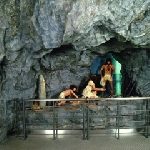
This museum overlooks Toyama Bay to the east. Otomono Yakamochi who compiled Manyoshu, the 8th century anthology of Japanese poetry, overlooked the same view and composed a poetry.
This museum presents an easy-to-understand introduction from Himi of the Jomon period to the modern era, with the Osakai Cave Diorama, ancient burial accessories of tombs, medieval stone towers, wooden Japanese boats, fishing gear, nostalgic tools lined with relocation houses, and Shishimai, Lion Dance Corner.
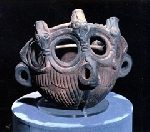
The museum introduces the history of the Suwa faith, such as the Onbashira Festival, huge pillars of fir tree are rollled, and Omiwatari, a phenomenon on Lake Suwa where ice cracks in large sections, called “the path of God crossing,” for the visiting legendary Goddess who crosses the lake. A number of materials, including treasures from Nagano Prefecture, and videos, are featured.
The Jomon pottery from the middle of the the Jomon period (16,000 years ago – 3,000 years ago), was excavated at Anaba site and is generally called Tsurite ware, Earthenware with a shallow bowl shape and a handle attached to the rim of the body. It is also considered to be a tool with a light like a lamp.
The upper half of the pottery has five animal patterns, which are thought to be snakes. It is a valuable resource for considering the faith and life of those days.
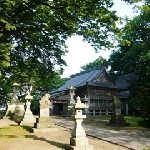
This shine is located along the coast of the Japan Sea in Murakami Niigata. It was the Sochinju, a central place of prayer for local gods in Ishifune county, Murakami, before the Asuka period of the 6th – 8th century. Nigihayahi no Mikoto, the ancestor god of the Mononobe clan, a powerful military clan in the 6th century, is enshrined here.
Nihon-shoki, the oldest chronicles of Japan from the 8th century, described this area. Iwafune no Saku was a fort was built during ancient times to protect against the Emishi, the term for non-Yamato people from northern Japan.
There are Uratamaya tombs, built in the 6th century, on the hills near the shrine. The construction style of the stone chamber tells the connection with Kyushu Island, Wakasa Fukui, and Sado Island, Niigata, along Tsushima Current in the Japan Sea.
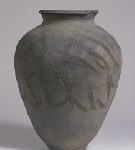
Suzu ware was produced in the vicinity of Suzu City from the end of the 12th century to the end of the 15th century. Suzu ware was the representative ware in the Medieval age and then suddenly disappeared. It inherited the technique of Sue ware, which had excellent water holding properties, and came from the Korea Peninsula in the Tumulus period (the 3rd– 7th century). Suzu ware was baked without glaze.
The museum introduces “phantom antique pottery”, through the exhibition of decorative vases such as “Suzu Kushime Kesadasuki mon ko, a Vase of Suzu Ware with a pectinate pattern and cross band pattern”, which was surrounded with a ripple pattern made by comb teeth, and “Shoin ware” in the end of the Edo period (1603 – 1868).
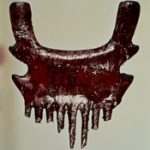
“Here is the origin of Japanese lacquer ware!” -As cool Japan, Japanese lacquer ware is now world renown. This museum’s collection includes one of those original pieces, a 6,100 year old red lacquered comb. This comb was excavated at the Torihama Shell Mound from the early Jomon period. This is symbolic of the highly skilled craft capabilities of the Jomon people.
A dugout (canoe) from about 6,000 years ago was also excavated from the Torihama Shell Mound, where the masterpiece “red lacquered comb” was excavated. These works tell us that the Jomon culture had highly-developed production techniques.
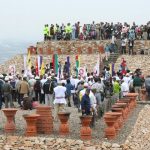
The southern Zenkojidaira, where the Chikuma River and the Sai River join, has been a source of rich soil and a large distribution center, since ancient times. In the Tumulus period in Japan, the king of Shinano chose the foot of Mt. Ariakeyama, along the Chikuma River, from which he could see his Kuni (domain). He built a keyhole tomb with a total length of about 100m on which stones were piled and lined with Haniwa (clay images).
This park restores the Yashiro Shimizu ruins pit houses, huts, and high-floor warehouses. The Mori-Shogunzuka Museum shows you how the Mura (Village) became the center of the Kuni (Domain) and the regional country.

The southern Zenkojidaira, where the Chikuma River and the Sai River join, has been a source of rich soil and a large distribution center, since ancient times. In the Tumulus period in Japan, the king of Shinano chose the foot of Mt. Ariakeyama, along the Chikuma River, from which he could see his Kuni (domain). He built a keyhole tomb with a total length of about 100m on which stones were piled and lined with Haniwa (clay images).
The bones of the Naumann Elephant were excavated and dismantled from Shinanomachi Town, at Lake Nojiri, about 40 km north from the Mori-Shogunzuka Tomb. The museum displays a full-scale model of Naumann Elephant and introduces Shinano Nagano from the Paleolithic period, too.

It is the largest wasabi (Japanese horseradish) garden in Japan, using the abundant spring water of Azumino Nagaono prefecture. Spring water is drawn to the wasabi field boasting an area of 3 Tokyo Domes (about 5ha x 3). The quantity of spring water is 120 thousand tons per day and the water temperature is 12 ° C. throughout the year.
Approximately 1.2 million people visit this each. Gishiki Hachmen the Great King who used to dominate this place along the Saigawa River in ancient times, fought the Imperial court.
The Great King Shrine was reconstructed and is located in the center of the farm.
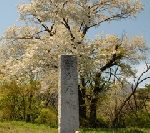
The site of Samegaojo Castle was on a low hillock at an altitude of less than 200m. Uesugi Kenshin (1530 – 1578), the feudal lord of Echigo Province, built it for the defense of the Shinano area of Nagano against the invasion of Takeda Shingen (1521 – 1573), the feudal lord of the Kai Province. After Kenshin’s death, it suffered the Siege of Otate, when the nephew and adopted son of Uesugi Kenshin fought each other for Kenshin’s inheritance.
This hillock has the Hida Ruins, which was the largest settlement in the Joetsu region of Niigata, in the latter part of the Yayoi period (the 4th BC – 3rd century). The Kanoundaira and Tenjindo tombs, behind the Hida Ruins were expanded in the 6th century. And there is the Hidajinja Shrine, which was founded in the beginning of the Heian period (794 – 1185) and worshiped in by Uesugi family.

The southern Zenkojidaira, where the Chikuma River and the Sai River join, has been a source of rich soil and a large distribution center, since ancient times. In the Tumulus period in Japan, the king of Shinano chose the foot of Mt. Ariakeyama, along the Chikuma River, from which he could see his Kuni (domain). He built a keyhole tomb with a total length of about 100m on which stones were piled and lined with Haniwa (clay images).
It was designed so that on the Vernal and Autumnal Equinox, the sun’s rays would be cast along the central line of this tomb. The sun informed the tomb as to when the festival began.
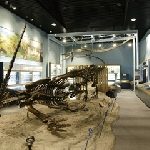
“The Islands sunk down and floated up” -Shinmachi is located at the north part of the Fossa Magna, the 6,000 meter deep land fissure created at the border of the Eurasia and the North American continental plates, 20 Million years ago. This town was at the Japanese Sea floor, 5 ‒ 4 Million years ago. This museum shows the sea floor fossils excavated here.
It exhibits fossils of the Paleozoic Era, such as trilobites, fossils of the Mesozoic Era when dinosaurs prospered, and fossils of the Cenozoic Era when humans were born. : Fossa Magna is the Great Rift Zone that opened in the middle of Honshu. It was named by Dr. Heinrich Edmund Naumann (1854 – 1927), a German geologist and teacher of Oyatoi Gaikokujin, the foreign employees in Meiji Japan.
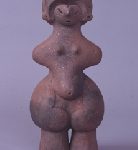
“Here, you will meet the National Treasure, Jomon Venus.” -Here you will see the Clay figure ,Dogu of the Jomon Venus, from the Tanabatake site in Chino. This Dogu, from the middle Jomon period, 5,000 – 4,000 years ago, is a large one, measuring 27cm tall and weighing 2.14 kg. This Dogu has very few broken pieces, unlike most Dogu found from that period.
Here you will see the Clay figure ,Dogu of the Jomon Venus, from the Tanabatake site in Chino. This Dogu, from the middle Jomon period, 5,000 years ago, is a large one, measuring 27cm tall and weighing 2.14 kg. This Dogu has very few broken pieces, unlike most Dogu found from that period. Of course, SHE is Venus! The museum is located in the historic park of the Togariishi site at the foot of Mt. Yatsugatake and Mt. Kirigamine, and displays cultural assets and materials excavated from Jomon period sites (16,000 years ago – 3,000 years ago).
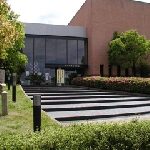
This museum exhibits Haniwa (clay images), and others at the end of the 4th century, excavated at Nobono Outsuka Tumulus, which is said to be the tombs of Yamato Takeru, a prince of Emperor Keiko, a hero in ancient Japan. It is said that he was exhausted, upon returning to the ancient capital Yamato Nara. After conquering the eastern area in Japan, he passed away at the Suzuka Pass and returned to Yamato as an incarnatied Swan.
The exhibited Haniwa are Morning-glory type cylindrical Haniwa (clay images) with fins. Their were numerous excavations of this style Haniwa in Yamato. This Haniwa indicates that the buried person of this tumulus had a strong connection with the Yamato administration (the Asuka period 592 – 710).

This area is a watershed that divides the Pacific Ocean and the Japan Sea in the center of Nagano Prefecture. Since about 10,000 years ago, the Chubu Mountains region had a unique culture and interacted with the Kant-East Japan, Kansai-West Japan, and Japan Sea sides- north Japan. In the Hiraide remains, 290 houses were found in a large village from the Jomon period to the Heian era (794 – 1192).
Hiraide museum possesses about 20,000 pieces of earthenware and stoneware excavated from the sites of a village that had lasted for 5,000 years, and exhibits the largest tile tower in Japan, from the later part of the Nara period (710 – 794).
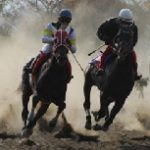
Mochizuki town has a history of having a ranch in the direct control of the Imperial court in Sakudaira, during the Heian period (794 – 1185). This town is known as the Komanosato, the village of the horse ranch.
This town holds a local horse race, on November 3 (Japanese Culture Day), every year, which is done on a 400m course. Local horses and horses from other prefectures, ponies, farm horses and thoroughbreds participate. Qualifying races in the morning and heated final rounds in the afternoon, are held.
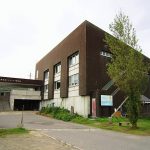
Bone Artifacts from 40,000 years ago! – This museum, located at the Lakeside of Nojiri, shows 1,000 of their79,000 relics of the Ice Age excavated from this lake. Tooth fossils from 40 Naumann Elephants were excavated. Visitors can see bone cleavers and scrapers made by the Nojiri people during the Paleolithic Age, 40,000 years ago. All of the roughly 85,000 items in this museum were excavated from Nojiriko Lake, since 1962. About 1,000 important fossils and relics are displayed.
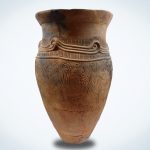
“A Settlement Compound spanning over 4,000 years“ -This site is one of the great settlement compounds from the Jomon period, 5,000 years ago, to the Heian period, 8th-12th Century. There are 20,000 excavated artifacts, including earthenware and stone implements. This area was a great central location through the watershed of central Japan, from the north to the south.
The Hiraide Iseki site is located on the depositional plain of the Narai River, originating from Mt. Kiso-Komagatake. Hiraide Museum is located in a hilly area overlooking the site, which possesses about 20,000 items excavated from this site. Nagano Prefecture was thought to be out of the distribution range of Dotaku, bronze bells, but discovering Shibamiya Dotaku of this museum’s collection, overturned that common sense. The discovery showed that Nagano had contact with the Tokai region facing Pacific Ocean.
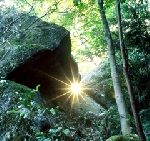
This megaliths site consists of Iwaya Iwakage site Megaliths, Megaliths of Higashinoyama and Megaliths with Petroglyph. The role of megaliths estimated more than 2500 years ago is an observatory that knows the turning point from solar operation.
The only megaliths that have a symbolic expression is Megaliths with Petroglyph, which have engraved the azimuth and altitude of the summer solstice in two lines. A lot of remains and earthenware from 8000 years ago are excavated around the site.
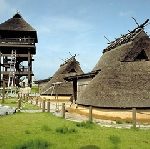
Makibanda ruins are located at the hill overlooking the Japan Sea, and at the foot of Mt. Daisen (height 1,729m), the highest mountain in the Chugoku region. The ruins were the Kokuyu, domain of the Yayoi period (4th century BC – 3rd century). There was a major community of the domain that reached the peak of power, during the Civil war of Wa, ancient Japan, which was registered in the first History of Japan, Gishiwajinden, an Account of the Wa, the history of the Wei Dynasty 3rd century.
The ruins tell us the existence of a powerful king, like the northern wall, a 2km long folding screen type rocks of Daisen.

This main shrine building was acclaimed by Taro Okamoto (1911-1996), Japanese Contemporary artist, as “What a savage awesomeness and a force it is”.
In 2000, a huge pillar bundle was excavated, with a slightly attached Bengara, red pigment from the 11th to 13th centuries. This indicates that there was a main shrine building that surpassed the Great Buddha of Todaiji Temple, Nara, in the late Heian period, in the 11th – 12th centuries.
Magatama, the ancient Japanese ornamental stone for sanctuary rituals, in the 4th century, was also excavated. It tells this shrine is a sacred place where prayers had been inherited.

This historical park preserves a wide area, approximately 30ha, mainly with tombs. In particular, Jorakuji and Nanatsuzuka Tombs are the largest in the Chugoku region, with 176 tombs on the gentle hills.
There are 116 tombs in the Jorakuji tombs group on the north side, and 60 tombs in the Nanatsuduka tombs group on the south side. There are round burial mounds, flat-topped burial mounds, keyhole tombs and scallop shaped tombs.
There is a promenade built in the 5th and 6th century, too.
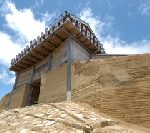
An ancient Korean-style mountain castle located at Mt. Kijozan (397m) was one of the castles built by the Imperial Court for the defense of Kinai, five lands area near the Imperial Court, after the defeat in the Battle of Hakusukinoe, the Paekche restoration war, in 663. This castle has water gates with the drainage function at the important point of the castle walls.
The ancient Kibi country had been controlled by the prince of Baekje, Ura until the dispatch by the Imperial court of Kibitsuhiko no mikoto, legendary Japanese, the son of Emperor Korei. This was the oldest site of iron manufacture in Japan, at the east foot of this castle site. Kibi no tsu, used to be islands, before land reclamation by drainage and pile.
The face of Oni, the devil became red by the fire of iron manufacture.
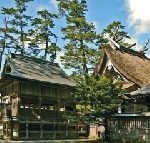
In Oki, floating on the northeastern sea of the Shimane Peninsula, a unique traditional culture has grown up, which merged the elegant aristocratic cultures of many exiles from the capital Kyoto with the various cultures carried by Kitamae-bune, cargo ships that sailed the Japanese Sea during the Edo period (1603-1868).
The architecture of this main shrine is also very unique. It is called Oki Zukuri style. A Kohai, an eave built over the steps of the worship and the main shrine connects the two. This style might have been the archetype for the ancient Inori, the prayer for harvest.
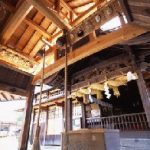
The fourth largest tomb in Japan is a 360m length of keyhole tomb from the first half of the 5th century. It is thought that this tomb was the largest in Japan at the time of construction. It tells of the existence of the Kibi king, which used to be comparable to the Great King in Kawachi, Osaka.
There is Kibiji Fudoki no Oka, Okayama Prefecture National Park as records of the culture and geography of this province, 4 km west of this tomb. The five-storied pagoda of Bichu Kokubunnji, state-supported provincial temple, quietly stands in a red pine forest of the park. That landscape blends rural scenery with historic sites, with harmony.
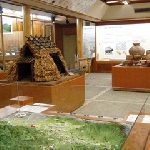
Tombs dot the plateau of Takanawa cordillera, overlooking Higash Iyoiiyo, Kagawa district. This museum introduces tombs in Asakura Kagawa, including Kinomoto tomb from the 5th century. Kankyo, a Chinese magic mirror, and a bronze mirror from the Han Dynasty (206BC – 220AD), was excavated at the Kinomoto tomb, which is exhibited at Tokyo National Museum.
The tomb and Kankyo indicates that Setouchi Kaido, the sea route, had been established byEmperor Ojin during the Kawachi Dynasty in the 5th century. It carried the civilization and culture from China to Nanba, in Kinai region, provinces surrounding Kyoto and Nara. Ojin was regarded as the guardian of warriors.
These also tell the birth of Japanese history, precisely.
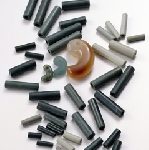
“Izumo, the Silicon Valley of the Yayoi period” —You can encounter National Treasures from the Kojindani Site, in the middle of Yayoi period, around 2000 years ago. It’s great artifacts include 358 bronze swords, 6 bronze vessels (Dotaku), and 16 bronze halberds. Those were used in agricultural festivals and were supplied to the“nation states”from Izumo.
The sacred device was an integrated circuit, IC, that connects harvest and labor. This museum introduces the origin of the Izumo Kingdom, along with a model of the largest shrine building in Japan, the ancient Izumo Taisha main shrine. The museum shows a large number of excavated bronze ware from the Yayoi period (the 4th BC – 3rd century), and the gold and silver swords that decorated the powerful family in the Izumo Province.
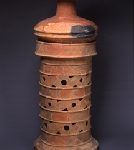
“Honoring Stone and Iron implements for cultivation” -At the Hyakukengawa sites in Okayama city, this complex contains settlements from the later Jomon period, 4,000 years ago, and the settlement from the early ‒ later Yayoi period, 4th Century BC – 3rd Century. Circular moats and Stone implements from the early Yayoi periods and Iron ones from the later Yayoi were found.
This center exhibits some of the items excavated from the Hyakukengawa sites. Rice existed in the Jomon period (16,000 years ago – 3,000 years ago) and there were paddy fields in its late period. In the Yayoi period (the 4th BC – 3rd century), ridges for adjusting the details of the plot were made to improve the efficiency.
And tools were improved, productivity was increased, and circular moat settlements were established, leading to the development of a large-scale base village. Eventually, a large-scale mound tomb was built and exchanges with various places became popular.
This center guides well the flow of ancient Japanese civilization.

The history exhibition room of this museum, exhibits the full-scale restored residence and others to convey the history of Ehime from the primitive age to modern times.
Hoketsu Pass (436m height), in Ashizuri-Uwakai National Park, looks down on terraced fields, Uwa Sea colored azure, and the Rias coast, with its striped patterns. It has long views of Kyushu Island.
Pottery and other objects from the Jomon period (16,000 years ago – 3,000 years ago), were excavated at Hoketsu Pass. It also indicates an ancient connection with the Osumi Peninsula in the southern Kyushu Island.
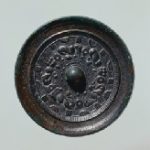
This museum introduces Iyo culture and Iyo Province as the historical interchange on the sea route. Kankyo: a bronze mirror from the Han Dynasty (206BC – 220AD), was excavated at Amayama jinja-kita ruins in Matsuyama City. It was at the time described in China, as the days of the Five kings of Wa, an old name for Japan.
Fudoki: a description of Japanese regional climate, culture, mentioned Dogo Onsen, a hot spring, in Ehime, along with the Kinai region, provinces surrounding Kyoto and Nara. These were from the days of the Kawachi Dynasty, started by Emperor Ojin, regarded as the guardian of warriors. Those indicate historically the big presence of Iyo Province, during ancient times.
With its 3000 year history, along with the legend of the Gods coming down to Yamato Province, Kinai and Iyo Province created Japan‘s provinces.
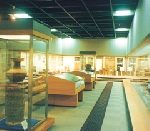
The Chugoku Mountains consist of old strata that contain a lot of iron. The Miyoshi Basin was a developed area from ancient times. It is one of the most crowed area of tombs in Chugoku province, with more than 4000 tombs. They make up one third of tombs in Hiroshima prefecture.
This museum exhibits excavated items such as Kudadama, tube balls made of jasper, small balls made of glass, Yariganna, an iron wood tool to smooth boards, and iron swords. The museum introduces the Miyoshi Basin’s historical development as a transit point in the Chugoku Mountains, along with the view of ancient Hiroshima prefecture.
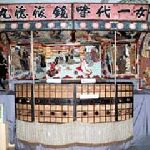
The museum exhibits fossils of the Naumann Elephant from about 250,000 to 20,000 years ago. The Seto Inland Sea used to be a paradise, where grasslands spread, connecting to the continent. Jomon Transgression commenced since about 19,000 years ago. The beauty of the Islands in the Seto Inland Sea is some remains of the paradise.
In addition, this museum introduces houseboats that used to live in groups and existed in the Seto Inland Sea until modern times. In the Sulu Islands in the Philippines, houseboats serve as marine vessels.

In the Kaifu River basin, Tokushima Prefecture, there is a megalithic tomb, Osato Burial Mound, which had the horizontal stone chamber and was built in the 6th century. The chamber was designed for the grave of Local King and faces the south.
This museum exhibits a diorama that has restored the original shape of the chamber. The thought continuing from ancient Japan, that the soul returns from Yomi, Hades, is clearly explained.
The Kaifu marine force is introduced by the sword of Kaifu, Awa Province, which was the descendent of Local Kings in ancient times.
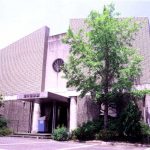
Dotaku, Bronze bells allegedly excavated in Kagawa Prefecture is possessed by Tokyo National Museum. They are of a similar mold as those excavated in Fukuoka. That indicates that Dotaku was transported from Kyushu Island to Shikoku Island. Comma-shaped copperware excavated in Morihiro Ruins, Sanuki City, from the Yayoi period (the 4th BC – 3rd century), was made from the same mold as the ones in Fukuoka, which were recently found in the Tokai region, too.
Comma-shaped copperware was used as amulets against temptations and enemies, of which the shape resembles a spider conch. Spider conch was believed to have the power against temptations in the Satuna islands, Kagoshima, and the Ryukyu Islands, Okinawa. Comma-shaped copperware, and Spider conch, shows the sea route from Ryukyu Islands, to the Tokai region of Honshuu Island.

“Honoring Olympic medalists and Ancient cultivators” – This museum is located at the Okayama Prefecture Athletic Stadium, which praises Olympic athletes from Okayama and introduces the Tsushima site, because this Stadium is built on a site from the early to later Yayoi period, 4th Century BC – 3rd Century.
The Tsushima site are the ruins of the era when full-scale rice paddy cultivation began.
-Rice existed in the Jomon period (16,000 years ago – 3,000 years ago) and there were paddy fields in its late period. In the Yayoi period (the 4th BC – 3rd century), ridges for adjusting the details of the plot were made to improve the efficiency.
-And tools were improved, productivity was increased, and circular moat settlements were established, leading to the development of a large-scale base village. Eventually, a large-scale mound tomb was built and exchanges with various places became popular.
The modern Olympic Games is a symbol of civilization that cultivates the sustainability of society. Pioneers of the ancient and modern days at this museum are waiting for you.
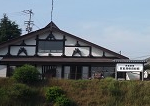
This museum exhibits cylindrical clay figures in the Tumulus period (the 3rd– 7th century), and part of a replica of a Comma-shaped copperware excavated from Morihiro Tenjin Ruins, Sanuki City, in the Yayoi period (the 4th BC – 3rd century). The shape resembles a spider conch, believed to have the power against temptations in the Satuna islands, Kagoshima, and the Ryukyu Islands, Okinawa.
This museum introduces the local history through these exhibits, that the culture from abroad from the sea route took root in this area, enhanced its economic power, and the power increased to be able to build a tumulus overlooking Seto Inland Sea.
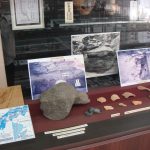
This museum exhibits archeological materials of the Paleolithic Period, the Jomon period (16,000 years ago – 3,000 years ago), the Yayoi period (the 4th BC – 3rd century), and Tumulus period (the 3rd– 7th century). Maruyama Tombs, in Kanonji City had a buried, hollowed-out, boat shaped sarcophagus, made of welded tuff from Mt. Aso, which was at the horizontal stone chamber in the early stage.
That indicates the possibility that the culture from abroad took root in this area, on the west coast of the Okushi Peninsula, which protruded into the Seto Inland Sea. This area’s sea route had continuous trade and human connections with Kyushu Island.

This tomb is the largest keyhole tomb in Shikoku Island, which was built in the first half of the 5th century, and symbolizes a tomb in Shikoku Island. Fukiishi, stones covering the slope of this tomb, used a lot of basalt and Kuro Aburaishi, black shining stone, from Sanuki, Kagawa. Comma-shaped copperware, from the the Yayoi period (the 4th BC – 3rd century) was excavated from this area and carried by the sea route.
This local history tells us that the culture from abroad took root in this area, enhanced its economic power, and the power increased to enable the development of a large civil engineering and construction industry, on the plateau overlooking the agriculture field.
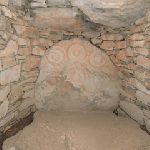
This burial mound is located in the eastern part of the Wakamiya Hachimangu shrine. It is a keyhole tomb considered to be the tomb of the chief in the first half of the 6th century. Various patterns were drawn on the entire wall of the Tunnel Tomb-type stone chamber in the circle of the keyhole tomb. Swords, shields, ships, fish, and beasts were also drawn, in the centering concentric circles and bracken patterns.
Image quality and expressiveness are different from Takamatsuzuka Tumulus and Kitora Tumulus in Asuka Nara from the end of the 7th century to the beginning of the 8th century.
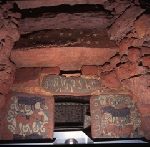
Fukuoka Keisen Town is located at the southern end of the Chikuho area. Around this area, stoneware that is considered to be from the 10th century BC to the 4th century BC has been excavated. These ancient tombs were built in the 6th century and is a National Historic site.
The biggest attraction of this tomb is the murals in the stone chamber with colorful decorations and patterns. The color shining in the dark shows a presence that is different in image quality and expressiveness from Takamatsuzuka Tumulus in Asuka Nara.
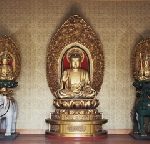
Gakurinji Temple, located in the western suburb of Hita City, was founded in 1342, according to an Imperial scroll written by Emperor Go-Daigo (1288 – 1339), who successfully overthrew the Kamakura shogunate and brought the Imperial House back into power (1333 – 1336). This museum is located on the precincts, and exhibits the Statue of the Buddha triad – Buddha attended by two Bosatsus, by Koyo, a Japanese sculptor of the Kei school and a descendant of five generations of Unkei (1150 – 1223).
This museum also exhibits excavated items from the Fukiage ruins, from the 3rd BC to the 1st century, including rare bracelets excavated around human bones. It is estimated that the Wide Pacific spiral shell bracelet was for adult males, and the cone shell bracelet was for adult females.
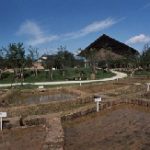
“This site is layered with Jomon and Yayoi” -This site is very unique. Above a site of rice farming from the final Jomon period, 3,000-2,000 years ago, there is the site of wet-rice farming, from the beginning of the Yayoi period, 2,000 years ago. The variety of the rice is the same as in South China. Ancient travelers came here!
This site is the oldest wet-rice farming site in the southwestern part of Karatsu City, which shows the beginning of ancient civilization in Japan. The Tsushima site are the ruins of the era when full-scale rice paddy cultivation began. Rice existed in the Jomon period (16,000 years ago – 3,000 years ago) and there were paddy fields in its late period. In the Yayoi period (the 4th BC – 3rd century), ridges for adjusting the details of the plot were made to improve the efficiency. And tools were improved, productivity was increased, and circular moat settlements were established, leading to the development of a large-scale base village.
Eventually, a large-scale mound tomb was built and exchanges with various places became popular. Matsurokan Museum introduces and explains well the origin and spread of rice farming from the Eurasia Continent, which had been connected by the Kuroshio, the Japan Current, since the Jomon period (16,000 years ago – 3,000 years ago).
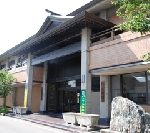
This museum is located at the foot of Mt. Kagamiyama (Height 284m) and near Kagami Shrine where it is said that Empress Jingou dedicated a mirror for the victory prayer when she went to the Korean peninsula.
This museum exhibits excavated items at the Nabata site which is the oldest rice cultivation site in Japan (about 2,500 years ago), the Kuri Sosui tomb, one of the oldest keyhole tombs in Japan in the early part of the Tumulus period (3rd – 7th century) and at the main ruins of Karatsu area to convey the richness of ancient times.
This museum tells us the real image of the country of Matsuro, registered in the first History of Japan, Gishiwajinden, an Account of the Wa, the history of the Wei Dynasty 3rd century, and Matsuura county in Nara era (710 – 794).

Chibusan Tumulus, in the Higo Ancient Forest of the Yamaga district, is a 6th century keyhole tomb, 44m long and 7m high. On the surface of the stone coffin, people, circles and triangles were drawn in three colors, red, white and black which were made of Aso soil pigment.
The museum has a detailed replica of the tumulus which is irregularly-opened to the public and can be viewed at any time. The original movie, and other displays, introduce us to the Decorated Tumulus before Asuka Decorated Tumulus in the 7th century.
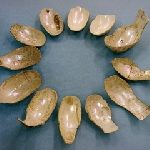
At Kominato Fuwaganeku suites from the 6th to 8th century, many shell products such as turban shell spoons and containers, and decorations of cone shell were excavated. The Turban shell, which were used in the mother-of-pearl work, were well excavated. Turban shell do not live on the mainland of Japan.
In the history books from the 7th century, the name of Amami was written and the treasure of Amami presented to Imperial Court were registered. At the adjacent area of the ruins, stone pots from Nagasaki Prefecture, which seems to have traded Turban shells, were also excavated.
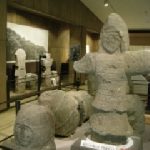
A group of 300 Yame burial mounds, from the 4th to the 7th centuries, are located on the Yame Hills, a 10km expanse, north of Yame city. Among the tombs, the Iwatoyama ancient tomb, from the first half of the 6th century, is the largest keyhole tomb in the north of Kyushu.
And this tomb is the one of Tsukushinokimi Iwai, the one-time king of this area. Stone statues of people, soldiers and horses excavated in large quantities from this tomb tell that he was the champion of northern Kyushu.
This center possesses and displays Haniwa (clay image), unglazed vessels, gold rings, gold earrings with hanging ornaments, iron weapons and armor excavated from the Yame burial mounds.

Mt. Fukuchiyama, one of northern Kyushu’s iconic mountains, is formed by an ancient stratum with granite piled. The slope of Kokura Kitakyuushu is gentle and the slope of Fukuchi Town is steep. At the steep slope of Fukuchi Town, there is Agano Valley, the source of the Fukuchi River. The center of the valley has the Shiraitonotaki Water Fall, which contains a lot of strange rocks along the 3km ravine.
In the early modern days, the Agano tea ware, which had a dominant influence in the world of tea pottery in Japan, is produced. The Agano tea ware is sintered in the red pine of Mt. Fukuchiyama, and its character is taken from the atmosphere of this valley.
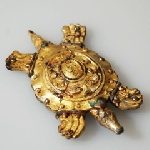
This museum is built on a small hill overlooking the Harunotusuji site, which is designated as a National special historic site. This museum exhibits approximately 2000 valuable properties and materials excavated from this island, including the Harunotsuji site.
“The Site of the capital mentioned in a 3rd Century Chinese history book” -The Chinese geography and history book from the 3rd century, Gishiwajinden, is the oldest record mentioning Japan. There are detailed descriptions of the nation states of Iki. Here are the combined treasures of mirrors, swords and jewels excavated at the state capital of Iki, the Harunotusuji site.
Iki Island is 17km north-south and 15km east-west. It is located in the Genkai-nada Sea between Kyushu Island and Tsushima Island. This museum displays many Chinese continental items and introduces the capital of the kingdom, which is the only place identified in Gishiwajinden.

Under the theme of “Kumamoto’s memory for the future”, this museum exhibits about 4100 items from ancient times to the present. This museum is an Integrated Museum of Nature, Humanity, and a planetarium.
In the Kofun period, Kumamoto, was called Hinokuni, the Volcano Province. The plating mirror and the harness on horses of an important cultural property from the Tumulus period (the 3rd– 7th century) are exhibited.
These were excavated from Saien Tumuluses, in Asagiri Town, Kuma district. This museum also introduces white porcelain excavated from the site of Rengeji Temple, from the Kamakura period (1185 – 1333) of the Medieval Ages as well as the relics excavated from the sites in Kumamoto Prefecture.
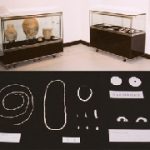
“The Road from the Paleolithic Age to the Space Age ” -Cooking implements made of stones in the Paleolithic Age, more than 30,000 years ago, were excavated at the Yokomine site in Tanegashima Island. This center possesses those relics.
The Ryukyu Arc consists of 199 islands, which are located like flower frames about 1,260km south of Kyushu Island in the Japanese archipelago. There are high islands with forests and flat islands with fresh spring water. Tanegashima is a flat island, which is suitable for carrying and launching space rockets.
In Tanegashima, the Shell Road Road, from ancient days, and the Guns Road, from the early modern age, overlap. Tanegashima developed a dynamic journey both now and in ancient times.

“Okinawa preserves the Paleolithic Age with limestone” -Paleolithic man arrived in Okinawa 36,000 years ago. They seem to be the Precursor of the Japanese people. You can see the bone collection of Minatogawa Man, the now-extinct Ryukyu deer, and the still-surviving flightless bird, yambaru kuina, from the Paleolithic Age 20,000 years ago. This general museum researches, preserves and displays natural history, archeology, history, folk and arts and crafts of Okinawa.
(Okinawa Islands were connected with Continental Eurasia 20,000 years ago in the last glacial period over the Yonaguni Channel, the Kerama Gap and the Tokara Channel.)
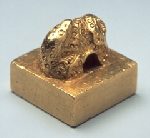
This museum exhibits the history and the folk culture of Fukuoka, which has long been a gateway to foreign exchange. The most well-known artifact is an imperial seal which was made of gold.
The seal was bestowed to a lord of a then existent Japanese country called “Na” and the gift was mentioned in a Chinese history book called “Book of Later Han Dynasty”. The Chu, which is the finger grip of the imperial seal, was cast to the shape of a snake, which is said to be given to kings of the surrounding countries around the ancient empire of China.
This seal contains valuable written inscriptions in 57AD and is historically significant.
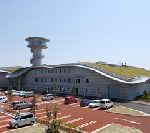
Kasen copper coin has a square hole in the circular form. Wan Mang (45BC – 23AD), who founded the Xin Dynasty, made it, in 14 AD. The National historic site, the ruins of Harunotusuji is in Iki, Nagasaki.
On the west side ruins of the hillock, a river channel, circular moats, pillar buildings and dug out holes were found. The Mumun pottery period in the Korean Peninsula and Yayoi pottery which were discarded together, were excavated from dug out holes.
Kasen copper coins along with earthenware, a carriage tool from the Lelang Commandery of the Korean Peninsula, an Iron hammer, a plate shaped Iron Axe, and an Iron Chisel, were excavated from the dug out holes. Kasen coppers were excavated from dug out holes, along with the river channel.
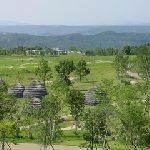
“The Pit dwelling houses for settlement, came!” -This site is located in the plateau of Uenohara and started in the early Jomon period, 7,500 years ago. This was the full-scale settlement of Jomon people. It had pit dwelling houses and open space for festivals. You can see here the movement of the settlement to this plateau by 2,500 years ago.
This site has settlements from the Jomon period (16,000 years ago – 3,000 years ago) that dates as far back as the Sannai Maruyama site in Aomori prefecture. In this site, there is a 7,500 year old open space for ceremonies, 3,500 year old hunting grounds, and 2,500 year old cooking facilities. At the archeological preservation museum that keeps the temperature and humidity in the designated historic site, you can observe the remains of the 9,500-year-old pit dwelling, as well as excavated stones and earth pits.
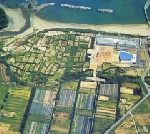
A cycad plant community spreads over this site where many Kaneku-type pottery peculiar to the Amami Archipelago, from the 7th to 11th centuries, were excavated. Cycads grow on rocks near the coast, become fertilizers and fuels, become windbreak and land borders, and are emergency food during famine.
Although the landscape of cycad field used to be seen throughout the Amami archipelago, it has almost disappeared due to the land improvement project.That traditional landscape exists over a large area on this site.
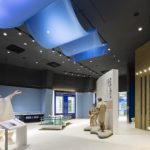
“The Road from the Paleolithic Age to the Space Age ” – Many bracelets made with shells from Okinawa Island, were excavated at the Hirota site, from the later Yayoi period, 1,700 years ago. The Shell Road to Kagoshima in Kyushu Island continues from here.
The Hirota site is a collective grave built on sand dunes that lasted until the Tumulus period (the 3rd– 7th century). There is no other culture in Japan where a large amount of shellfish products were buried in a grave.
This overlaps the Shell Roads of ancient civilizations that have interacted extensively with the Japanese archipelago before the Tumulus period. In ancient times, shellfish was wealth and trade goods. There was technology to produce the goods. Romance is based on technology.
This museum exhibits relics from the Hirota site, and you can also experience making ancient shellfish accessories.
And from this site, you can see modern technology, the Tanegashima Space Center.

Fukuoka City, has flourished as a gateway to external negotiations since ancient times, and has over 1000 ruins. The Permanent exhibition of this center focuses on the Country of Na, a country that existed within Japan during the Yayoi period (4th century BC – 3rd century) and the period of the largest trading port in Japan, the “Medieval City Hakata”.
The Sword with a ring pommel, with a dragon motif, has two dragons facing the handle of the iron sword, and an elaborate relief-like pattern made of gilt bronze. This is similar to the Long sword ornament of Kaya, an area of iron production, in the southern part of the Korean peninsula.
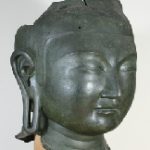
Usa Fudoki no Oka, the hill to record the culture and geography of this province, has ancient tombs built at the end of the 3rd century, which are looking down on the Usa Plain, overlooking the Buzen Sea. The mirrors, burial accessories similar to those of tombs in Fukuoka and Kyoto were excavated at those tombs. Those show tight bonds with the Yamato administration (the Asuka period 592 – 710).
This museum is located on this hill and exhibits molding statue of the Buddha triad of Tenpukuji Temple and the restoration of Fukiji temple Big Hall. It also introduces the history and culture of temples in Rokugoumanzan, Kunisaki Peninsula, of Usa province and Usa Jingu shrine.
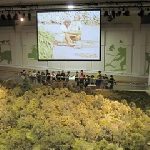
“Here, you will know the start of the Jomon period.” -This museum, located in Jiganji Park, guides well the ruins in Kagoshima city, and the relics of stone implements and unglazed earthenware that was excavated there, since the Paleolithic Age and the start of the Jomon period (16,000 years ago – 3,000 years ago). You can simulate the excavation and touch the relics, too.
This museum introduces the Sojiyama site, from the beginning of the Jomon period, with one of the largest models in our country. It is one of the oldest settlements in Japan, along with the Kusano Shell Mound and its excavated relics from the later Jomon period.
This museum also introduces, via a large video screen, the history of Kumaso, a tribe living in the ancient southern Kyushu Island that did NOT serve the Yamato Court, and Hayato, a tribe living in the ancient southern Kyushu Island that DID serve the Yamato Court. Both lived in South Kyushu with their own culture.

This center shows the natural scenery of Yakushima. Jomonsugi cedar, estimated to be from 2,000 to 7,200 years old with ancient memories, and the nature of Yakushima Island are featured on a large-scale screen.
The white and beautiful Nagata Beach is wide, where the loggerhead turtle lands and lays the largest number of eggs in Japan. This Beach is also registered as one of Ramsar Convention sites. The center also introduces the relationship between the sea turtle, Kuroshio, the Japan Current, and Yakushima.
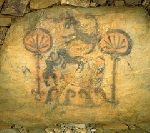
This Ancient Burial Mound is a mural tomb from the later part of the 6th century. Although many decorative tombs are abstract paintings, these murals feature concrete paintings. Takamatsuzuka Tumulus in Asuka Nara, which is famous as a concrete decorated Tomb, was built at the end of the 7th century.
The subject of these murals are presumed as Suzaku (red Chinese phoenix) and Genbu,(black tortoise), and they are the same as ones in Koguryo Tombs in the Korean peninsula.
Along with the Takamatsuzuka Tumulus, there is no other example of a Japanese decorated tomb. Burial accessories, like jewel balls, glass balls, gold rings, harnesses and arms have been excavated.
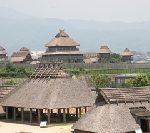
“The Largest site from the Yayoi period” -This site continued for 700 years of settlements since 3rd Century BC. Visitors can see the center of the “nation state” from the Yayoi period, where relics found, including copper/bronze knives and decorative glass beads, show the extremely high academic value of this site.
This park is a monumental park of a 117 ha. Moat Encircled Settlement (Village) in the Yayoi era, 2,000 years ago. It consists of three zones: Moat Encircled Village Zone, Ancient Field Zone, and Ancient Forest Zone.
The Moat Encircled Village Zone has the north inner wall, where the huge shrine building is restored, the south inner wall, where the residences of the ruler are restored, and the restored west side building, which managed the warehouse and the market. The Ancient Field Zone reproduces the landscape of ancient rice paddies in the summer and wheat fields in the spring.
The state of Yoshinogari at that time accumulated foreign affairs and trade with China and learned the rituals of the Chinese dynasty, the protocol of the guest ceremonies, castle structures, and calendars. The restored architecture shows its formality.
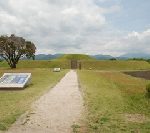
Saitobaru tombs is the largest tomb area in Japan. It is located 30 km north of Miyazaki City. Construction of those tombs began from the 3rd century and many mysteries remains. Osahozuka tomb is the largest keyhole tomb in Japan, with a total length is 176m.
Oni No Iwaya Burial Mound is similar to the burial mounds of Continental China and the Korean peninsula. The only similar tomb in Japan is Ishibutai Tumulus in Aska Nara. And in this tombs area, there are Mound Tombs, Underground Tombs, and South Kyushu’s special Tunnel Tombs.
